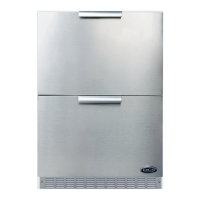13
If low side pressure is below pressure in Table B, check for the following:
A system leak1.
Capillary tube or evaporator is restricted2.
Insucient compressor (does not pump properly)3.
If low side pressure is above pressure in Table B, check for the following:
Restricted air ow1.
Dirty condenser coil2.
Overcharged system3.
Low side leak4.
Inecient compressor5.
3.8 RE-CHARGING
Re-charging of the unit should be done only after diagnosing and repairing the system. Be sure to ush the system with dry nitro-
gen gas and evacuate to 50 microns before re-charging.
The method for re-charging the unit is by weight using vapor refrigerant. Using manifold gage set-up, hook up charge hoses to
the access valve on the compressor’s process tube. If any access valve is attached to the high side process tube, remove it and
then seal the tube by brazing before charging. Charge the unit to specied amount (see Section 1.1, Unit Specications for charge
specications per model).
After re-charging the system, check pressures and refer to Table B for corresponding temperatures and pressures. If pressures are
incorrect, check the sealed system, recover the charge, repair, evacuate, and then re-charge.
It is normal to have some condensation or slight frost on the suction line. Typically this will occur towards the end of a run cycle. If
the frost continues down the suction line to the compressor, the system is overcharged. It is important that the insulation re-
mains on the suction line and the capillary tube together after any repair and that it is sealed on both ends. Be sure to replace the
refrigeration putty in the hole of the foam where the refrigerant lines go through the back of the unit. Spread the putty out evenly
lling in the cracks to prevent air from leaking in and out.
SEALED SYSTEM

